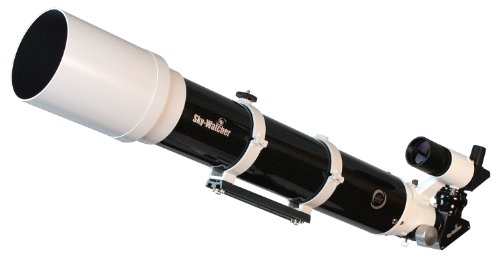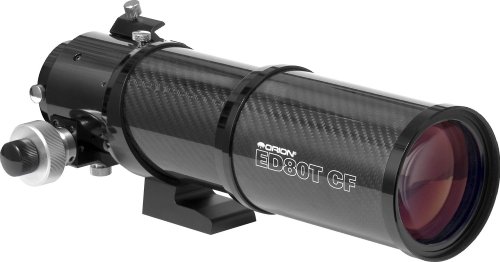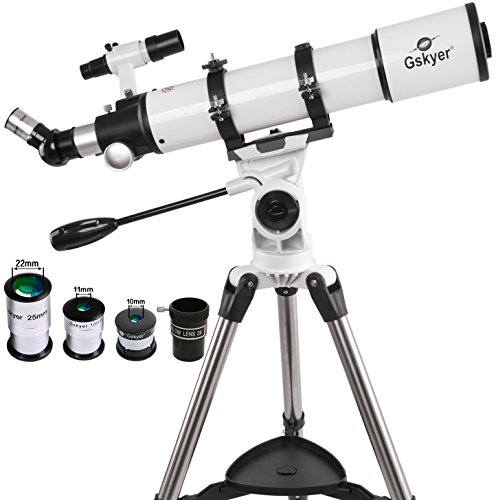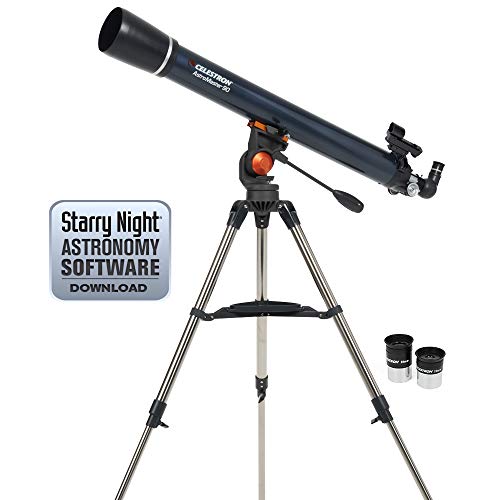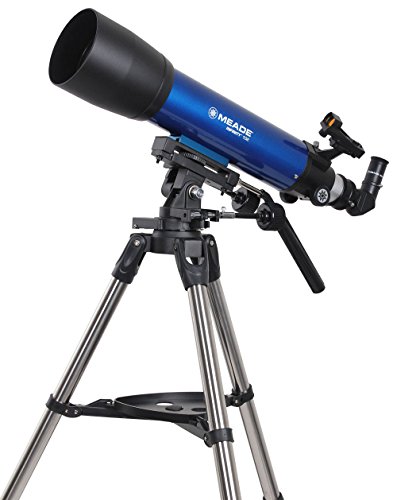5 Best Refractor Telescopes of 2025 – Top Picks & Reviews
Last Updated on
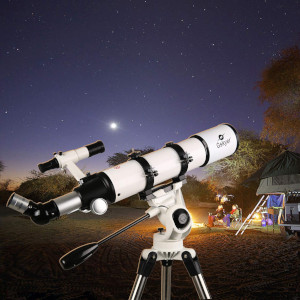
A good telescope can open up the entire universe. Give you access to infinity all from the comfort of your backyard. If you are considering getting a telescope, either for recreational or academic purposes, you’re in good company. Many of history’s greatest thinkers were stargazers.
But buying the right telescope is no walk in the park. Sometimes, the specifications alone require a graduate degree just to understand. And then there is always the worry that the product you are buying is a dud.
Naturally, you don’t want that. For as awesome as they are, telescopes are also quite pricey. Wouldn’t it be great to have the peace of mind of knowing your money is being well spent?
We aim to give you that peace of mind. We have assembled five refractor telescope reviews that will help make your decision as easy as possible. All that’s left for you to do is relax, and enjoy discovering the telescope that will introduce you to our galaxy.

A Quick Glance at Our Favorite Picks in 2025:
| Image | Product | Details | ||
|---|---|---|---|---|
| Best Overall |
 |
Sky-Watcher 120mm |
|
CHECK PRICE |
 |
Orion ED80T |
|
CHECK PRICE | |
| Best Value |
 |
Gskyer |
|
CHECK PRICE |
 |
Celestron AstroMaster |
|
CHECK PRICE | |
 |
Meade Infinity 102mm |
|
CHECK PRICE |
The 5 Best Refractor Telescopes:
1. Sky-Watcher 120mm Refractor Telescope – Best Overall
We start strong with the Sky-Watcher. This is a heavy-duty unit, but it’s also one of the best refractor telescopes for astronomy out there.
Clarity is the name of the game here. The telescope features an ED lens (extra-low dispersion) for crystal clear image rendering, which is a cut above the standard optical lenses that you see most commercial telescopes toting.
It’s also capable of both terrestrial and celestial viewing which makes it perfect for multi-faceted pro-level observations.
With specialty accessories, you can also attach high-quality cameras to the unit to do some astrophotography.
Last but not least, the telescope also comes with a durable aluminum carrying case so that you can safely transport it from place to place.
Granted, these premium features don’t come free. This is an expensive unit that only serious astronomers will want to consider.
To up the cost even more, this unit doesn’t come with any sort of mount, which means you’ll need to buy it separately.
Still, if you’re using this telescope for research purposes, the high-quality features will be well worth the money that you spend on them.
- Crystal clear image rendering
- Attachments for mounting camera
- Easy to transport
- ED Glass
- Very Pricey
- Mount not included
2. Orion ED80T Refracting Telescope
If you like our first pick, but don’t like its price, you may find the Orion to be an attractive alternative. This unit has many features in common with our number one pick, but it comes with a price tag that is a little bit more palatable.
Once again, you get ED glass with this unit which many see as the gold standard. You also get an 80mm aperture lens which will give you a richly detailed look at space even with high levels of magnification.
Its compact size and lightweight make this the perfect telescope for amateur or hobbyist astronomy. It will be easy to move from place to place, while still being strong enough to clearly render images.
It also comes with a foam-padded carrying case for an added level of safety when you transport it.
Our primary concern is about the product’s durability. The hardware feels a little flimsy, especially given the price point. Considering how often telescopes are used, more durability is usually ideal.
- Affordable (relatively speaking)
- Carrying Case
- ED Glass
- High Aperture
- Flimsy Hardware
3. Gskyer Refractor Telescope – Best Value
Our “best for the money” pick might also be the best refractor telescope for beginners. The last two options we looked at are more for academic use. The Gskyer will be better suited for introducing you to the world of astronomy.
It features 90mm of aperture for crystal clear image rendering from great distances, and a maximum magnification level of 120x for long-distance viewing.
It’s also affordable and comes with a tripod so that you will have everything you need to get started right out of the box.
Lastly, it even features Bluetooth compatibility with your smartphone so that you can easily take images of what you find on your telescope.
These simple, approachable features will make this unit easy for people, who have never even touched a telescope before, to start using it right away.
One issue to look out for is the telescope’s range of motion on the mount. The unit doesn’t lock in well, so if you touch it even slightly, the telescope will move quite a bit. Naturally, this is not ideal for serious observation, when even the smallest movements can have a large impact.
Finally, it doesn’t work very well for terrestrial viewing. That’s not what most people will want the telescope for anyway, but if it is your intention, you may experience frustration.
For the price, this is one of the best refractor telescopes you can buy to explore the universe.
- Affordable
- Bluetooth
- High level of aperture
- Not good for terrestrial viewing
- Easy to accidentally move the telescope too much
4. Celestron AstroMaster Refracting Telescope
With the Celestron, we have a basic telescope. The biggest selling point for this unit will probably be the price tag. It’s affordable enough to suit most budgets, and it comes with all of the basic gear you need to get started.
You get a stable mount, the telescope itself, and even something the manufacturer calls “stargazer software”—a computer program that will better introduce you to the world of telescopes.
Ultimately, however, you are limited in what you will be able to accomplish with this unit. It’s better suited for viewing stars than planets.
If you don’t mind the limitations, it’s still a good telescope at an accessible price point.
- Affordable
- Comprehensive Package
- Limited range of what you’ll be able to view
5. Meade Infinity 102mm Refractor Telescopes
Last, we have the Meade Instruments Infinity. This product looks good at a glance. You get a high level of aperture. With 102 mm circumference, you should have no problem getting a crystal clear view.
It also comes with a mount that features precision controls so that you can move your telescope smoothly and steadily at a pace you’re comfortable with.
It even comes with supplemental instructional software and a DVD to fill you in on the basics of using a telescope.
That said, there are some problems. For one thing, it’s pretty flimsy. You always want to be delicate with a telescope, but that is particularly true with this one.
The stand itself is also rickety. If you’re out on a breezy day, you will find it very difficult to work with, as the telescope will be moving/vibrating constantly.
It’s not a terrible telescope by any means, but these flaws are what keeps it at the bottom of our list.
- Affordable
- Comprehensive package for beginners
- Fragile
- Hard to use with stand in the breeze

Buyer’s Guide – How to Choose the Best Refractor Telescope
Lots of factors go into buying a refractor telescope. We will now explore some of them as we dive into the buyer’s guide. Read on!
Aperture
The aperture is the feature that impacts how much light is presented in the image you ultimately see.
Aperture is typically measured in millimeters, though you may sometimes see it represented in inches, especially with beginner telescopes.
Ideally, you’ll be able to get something with at least 2.8 inches, or 70 millimeters of aperture diameter.
Aperture makes finer details more distinct, especially if you’re located in a place that has lots of light in the evening. Like a city.
However, if you’re in a more rural community, you’ll be able to get away with using much less aperture. For example, you might be able to see just as much with 3 inches of aperture in the countryside as you would with 6 inches in the city.
What’s Your Purpose?
Purpose will ultimately be a big determinant regarding which option you go with. If you’re going to be using the telescope for academic purposes, you’ll probably need something with top-notch specifications pertaining to range and aperture.
If you’re looking for something to satisfy casual curiosity, however, you can go much more basic.
A good telescope is an investment, but also one that is well worth the money. Going into the purchasing decision with a well-defined idea of what you’ll be using the telescope for will help ensure you don’t get more than you need.
Stand
You are going to want a telescope with a good stand. Some units come with mounts, some don’t. Similarly, not all mounts that come with telescopes are great. Sometimes it might be prudent to consider getting something a little bit better suited for your needs.
Entry-level stands might operate similarly to a camera tripod, with a single screw mount, and a limited range of motion that makes it somewhat hard to see everything that you want to see.
Ideally, you’ll want something a touch more workable than that.
Altitude-azimuth mounts (colloquially referred to as alt-az mounts) feature a sturdy connection point, and an up, down, and sideways range of motion.
There are also variants to consider, with a single axis range of motion that makes it easier to track stars.
If you’re just beginning, you will probably want an alt-az mount, since these units make it a tad easier to explore the sky freely.
However, if you’re buying with a specialized purpose in mind, you might look for a stand better suited to facilitate it. Telescopes are precision instruments, and their mounts can be similarly precise when needed.
GoTo
The GoTo mount is a stand that deserves its own category. GoTo mounts are motorized and usually include a computerized keypad. You type in your location and the date, and the mount can mechanically go to interesting star systems.
This sort of feature makes amateur astronomy about as easy as it gets. Of course, these mounts are also on the pricey side. But some may find it well worth the money.
However, keep in mind that these mounts are often strictly operated by the computer. Convenient though that might be, it does also dampen the experience of exploration and discovery that people tend to enjoy when using their telescopes.
Magnification
Magnification is important, but only if it corresponds with a high level of aperture. Remember, aperture is the component that renders finer details and makes them observable.
A telescope could magnify infinitely—but without good aperture it won’t matter. Generally speaking, you will only be able to detect a magnification of 50X the number of inches you have of aperture.
In other words, if the aperture circumference of your telescope is 3 inches, the maximum level of magnification it will be able to effectively deliver is 150X.
Granted, manufacturers may not advertise it that way. But that’s the reality.
Portability
While big telescopes have their place, there is much to be said about the value of a smaller unit. Small telescopes are easy to take with you on fun adventures. A hike, a camping trip, even your backyard.
The easier a telescope is to move around, the more likely it is that you’ll get good use out of it.
This may be especially true if you live in a city. There are two ways to contend with city lights. One way is to get something powerful enough to cut past them. The telescope that will be capable of doing this is expensive—and very large.
The other method you might consider is to purchase a smaller-sized telescope that you can easily transport out of the city.
Remember that size is not everything. High quality comes in a variety of packages. And smaller telescopes will often also be a little bit more affordable.
Price
Buying on a budget can prove a little bit tricky with telescopes. This is especially true if there are specifications you need the unit to have pertaining to magnification and aperture.
Great telescopes can cost thousands of dollars. Depending on your needs, you’ll probably be able to avoid spending that much. But the bottom line is that quality will cost money.
Recreational telescopes are a whole different ball game. If you’re buying this to set up and stargaze from a backyard, you can probably find something suitable for under $100.
Unfortunately though, if your ambitions exceed showing your kids the Milky Way from your backyard, you may need to budget for something that is pricey.
You could go over our lists of the top 5 telescopes under $500 and best under $300 to get some more ideas.
Age
Telescopes are a popular gift for children as well as for adults. If you’re buying for a child, look for products that are specially optimized for young users. Ordinary telescopes might be too difficult for them to make good use of.
The user’s first telescope should engage the mind without causing frustration.
Binoculars are also a low-cost alternative to telescopes for beginners of every age. They allow you to dip your toes in the waters of astronomy without spending a ton of money to do it.
Glass
Last but not least, glass. The majority of commercial telescopes come with optical glass. It’s the same material that is used on many camera lenses. Optical glass is usually reliable, though quality can range depending on the product.
If you look at higher-end units, however, you might find something called extra-low dispersion glass. This material is generally thought to be better at producing crisp imagines, but it will also cost more money.
NOTE: we recently compared refractor telescopes to reflector telescopes. See our findings here.

Conclusion
Hopefully, our reviews of the best refractor telescopes have helped you to understand your options. If you need a little bit of extra help though, please feel free to recall our recommendations.
If you are using this telescope for serious astronomical study, you’ll want the Sky-Watcher. Though pricey, it features specifications that are truly hard to beat.
However, if you’re going to have a more casual relationship with the telescope, and want to save some money, think about the Gskyer, a high-quality, low-cost alternative for beginners.
Of course, we don’t want to tell you what to do. You’ve learned plenty about telescopes from our reviews. Use that information to pick one that is perfect for your needs.
Looking for gift ideas for astronomy lovers? Read our new post here!
About the Author Robert Sparks
Robert’s obsession with all things optical started early in life, when his optician father would bring home prototypes for Robert to play with. Nowadays, Robert is dedicated to helping others find the right optics for their needs. His hobbies include astronomy, astrophysics, and model building. Originally from Newark, NJ, he resides in Santa Fe, New Mexico, where the nighttime skies are filled with glittering stars.
Related Articles:
How to Clean a Refractor Telescope: Step-by-Step Guide
How to Clean a Telescope Eyepiece: Step-by-Step Guide
How to Clean a Rifle Scope: 8 Expert Tips
Monocular vs Telescope: Differences Explained (With Pictures)
What Is a Monocular Used For? 8 Common Functions
How to Clean a Telescope Mirror: 8 Expert Tips
Brightfield vs Phase Contrast Microscopy: The Differences Explained
SkyCamHD Drone Review: Pros, Cons, FAQ, & Verdict




